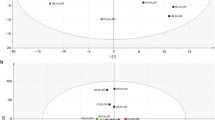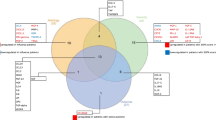Abstract
Late-onset sepsis (LOS) and necrotizing enterocolitis (NEC) are severe life-threatening conditions for neonates. Accurate, early diagnosis and timely initiation of treatment are crucial. Non-specific overlapping clinical signs along with the non-sensitive/specific diagnostic tools set obstacles to speedy, trustful diagnosis including differential diagnosis. The objective of this study was to evaluate the potential of targeted LC-MS/MS proteomics in identifying diagnostic biomarkers of NEC or LOS. We conducted a prospective case-control study evaluating serum proteomics profiles of 25 NEC, 18 LOS, and an equal number of matched control neonates, over three sampling points. Eighty-three concatemers and synthetic peptides belonging to 47 protein markers of the two diseases were selected after thorough literature search. A novel selected reaction monitoring (SRM), LC-MS/MS method was developed for their analysis and evaluation as potential biomarkers. Multivariate and univariate statistical analyses highlighted significant proteins in differentiating LOS and NEC neonates and diseased from controls. Moreover, panels of proteins were tested for their ability to distinguish LOS from NEC and controls. We suggest two panels of three proteins each, exhibiting very high diagnostic value for LOS and excellent diagnostic performance at the critical LOS-NEC differentiation, reaching an AUC ROC value close to 1 (0.999). These panels constitute a valuable starting point for further validation with broader cohorts of neonates, aiming to improve the clinical practice.

ᅟ




Similar content being viewed by others
References
Stoll BJ, et al. Trends in care practices, morbidity, and mortality of extremely preterm neonates, 1993-2012. JAMA. 2015;314(10):1039–51.
Eaton S, Rees CM, Hall NJ. Current research in necrotizing enterocolitis. Early Hum Dev. 2016;97:33–9.
Rossi P, Botgros R. Report on the expert meeting on neonatal and paediatric sepsis. EMA/477725/2010, 2010.
Sharma R, Hudak ML. A clinical perspective of necrotizing enterocolitis: past, present, and future. Clin Perinatol. 2013;40(1):27–51.
Stoll BJ, et al. Late-onset sepsis in very low birth weight neonates: the experience of the NICHD neonatal research network. Pediatrics. 2002;110(2 Pt 1):285–91.
Shah J, Jefferies A, Yoon E, Lee S, Shah P, on behalf of the Canadian Neonatal Network. Risk factors and outcomes of late-onset bacterial sepsis in preterm neonates born at < 32 weeks’ gestation. Am J Perinatol. 2014;32(07):675–82.
Bassler D, et al. Using a count of neonatal morbidities to predict poor outcome in extremely low birth weight infants: added role of neonatal infection. Pediatrics. 2009;123(1):313–8.
Tepas JJ, et al. Trajectory of metabolic derangement in infants with necrotizing enterocolitis should drive timing and technique of surgical intervention. J. Am. Coll. Surg. 2010;210(5):847–52, 852–854.
Han YY, et al. Early reversal of pediatric-neonatal septic shock by community physicians is associated with improved outcome. Pediatrics. 2003;112(4):793–9.
Niemarkt HJ, et al. Necrotizing enterocolitis: a clinical review on diagnostic biomarkers and the role of the intestinal microbiota. Inflamm Bowel Dis. 2015;21(2):436–44.
Delanghe JR, Speeckaert MM. Translational research and biomarkers in neonatal sepsis. Clin Chim Acta Int J Clin Chem. 2015;451(Pt A):46–64.
Cao Z, Robinson RAS. The role of proteomics in understanding biological mechanisms of sepsis. Proteomics Clin Appl. 2014;8(1–2):35–52.
Buhimschi CS, et al. Using proteomics in perinatal and neonatal sepsis. Hopes and challenges for the future. Curr Opin Infect Dis. 2009;22(3):235–43.
Jiang P, Siggers JLA, Ngai HH-Y, Sit W-H, Sangild PT, Wan JM-F. The small intestine proteome is changed in preterm pigs developing necrotizing enterocolitis in response to formula feeding. J Nutr. 2008;138(10):1895–901.
Cao Z, Yende S, Kellum JA, Angus DC, Robinson RAS. Proteomics reveals age-related differences in the host immune response to sepsis. J Proteome Res. 2014;13(2):422–32.
Ng PC, et al. Host-response biomarkers for diagnosis of late-onset septicemia and necrotizing enterocolitis in preterm infants. J Clin Invest. 2010;120(8):2989–3000.
Stewart CJ, et al. Metabolomic and proteomic analysis of serum from preterm infants with necrotising entercolitis and late-onset sepsis. Pediatr Res. 2016;79(3):425–31.
Sylvester KG, et al. Urine protein biomarkers for the diagnosis and prognosis of necrotizing enterocolitis in infants. J. Pediatr. 2014;164(3):607–612.e1–7.
Sylvester KG, et al. A novel urine peptide biomarker-based algorithm for the prognosis of necrotising enterocolitis in human infants. Gut. 2014;63(8):1284–92.
Aebersold R, Burlingame AL, Bradshaw RA. Western blots versus selected reaction monitoring assays: time to turn the tables? Mol Cell Proteomics MCP. 2013;12(9):2381–2.
Simpson DM, Beynon RJ. QconCATs: design and expression of concatenated protein standards for multiplexed protein quantification. Anal Bioanal Chem. 2012;404(4):977–89.
Wolters JC, et al. Translational targeted proteomics profiling of mitochondrial energy metabolic pathways in mouse and human samples. J Proteome Res. 2016;15(9):3204–13.
Buhimschi CS, et al. Proteomics mapping of cord blood identifies haptoglobin ‘switch-on’ pattern as biomarker of early-onset neonatal sepsis in preterm newborns. PloS One. 2011;6(10):e26111.
Shen Z, et al. Sepsis plasma protein profiling with immunodepletion, three-dimensional liquid chromatography tandem mass spectrometry, and spectrum counting. J Proteome Res. 2006;5(11):3154–60.
de Paiva RA, David CM, Domont GB. Proteomics in sepsis: a pilot study. Rev Bras Ter Intensiva. 2010;22(4):403–12.
Soares AJC, Santos MF, Trugilho MRO, Neves-Ferreira AGC, Perales J, Domont GB. Differential proteomics of the plasma of individuals with sepsis caused by Acinetobacter baumannii. J Proteome. 2009;73(2):267–78.
Kalenka A, Feldmann RE, Otero K, Maurer MH, Waschke KF, Fiedler F. Changes in the serum proteome of patients with sepsis and septic shock. Anesth Analg. 2006;103(6):1522–6.
Gundry RL, et al. Preparation of proteins and peptides for mass spectrometry analysis in a bottom-up proteomics workflow. Curr Protoc Mol Biol. 2009; https://doi.org/10.1002/0471142727.mb1025s88.
MacLean B, et al. Skyline: an open source document editor for creating and analyzing targeted proteomics experiments. Bioinformatics. 2010;26(7):966–8.
Xia J, Broadhurst DI, Wilson M, Wishart DS. Translational biomarker discovery in clinical metabolomics: an introductory tutorial. Metabolomics. 2013;9(2):280–99.
Eriksson L, Byrne T, Johansson E, Trygg J, Vikström C. Multi- and Megavariate data analysis basic principles and applications: Umetrics Academy; 2013.
Gilfillan M, Bhandari V. Biomarkers for the diagnosis of neonatal sepsis and necrotizing enterocolitis: clinical practice guidelines. Early Hum Dev. 2017;105:25–33.
Yang Y-X, Li L. Identification of potential biomarkers of sepsis using bioinformatics analysis. Exp Ther Med. 2017;13(5):1689–96.
Sammalkorpi K, Valtonen V, Kerttula Y, Nikkilä E, Taskinen MR. Changes in serum lipoprotein pattern induced by acute infections. Metabolism. 1988;37(9):859–65.
Levels JHM, et al. Alterations in lipoprotein homeostasis during human experimental endotoxemia and clinical sepsis. Biochim Biophys Acta. 2007;1771(12):1429–38.
van Leeuwen HJ, Heezius ECJM, Dallinga GM, van Strijp JAG, Verhoef J, van Kessel KPM. Lipoprotein metabolism in patients with severe sepsis. Crit Care Med. 2003;31(5):1359–66.
Chien J-Y, Jerng J-S, Yu C-J, Yang P-C. Low serum level of high-density lipoprotein cholesterol is a poor prognostic factor for severe sepsis. Crit Care Med. 2005;33(8):1688–93.
Kumaraswamy SB, Linder A, Åkesson P, Dahlbäck B. Decreased plasma concentrations of apolipoprotein M in sepsis and systemic inflammatory response syndromes. Crit Care Lond Engl. 2012;16(2):R60.
Yildiz B, Ucar B, Aksit A, Aydogdu SD, Colak O, Colak E. Diagnostic values of lipid and lipoprotein levels in late onset neonatal sepsis. Scand J Infect Dis. 2009;41(4):263–7.
Grion CMC, et al. Lipoproteins and CETP levels as risk factors for severe sepsis in hospitalized patients. Eur J Clin Investig. 2010;40(4):330–8.
Sarafidis K, et al. Urine metabolomics in neonates with late-onset sepsis in a case-control study. Sci Rep. 2017;7:45506.
Phua J, et al. Characteristics and outcomes of culture-negative versus culture-positive severe sepsis. Crit. Care. 2013;17(5):R202.
Acknowledgements
This research has been co-financed—via a program of State Scholarships Foundation (IKY)—by the European Union (European Social Fund (ESF)) and Greek national funds through the action entitled “Scholarships programme for postgraduate studies—2nd Study Cycle” in the framework of the Operational Programme “Human Resources Development Program, Education and Lifelong Learning” of the National Strategic Reference Framework (NSRF) 2014–2020.
Author information
Authors and Affiliations
Contributions
Anastasia Chrysovalantou Chatziioannou, Kosmas Sarafidis, Georgios Theodoridis, Justina Clarinda Wolters, and Rainer Bischoff conceived and designed the study and contributed to the realization of the analysis. Anastasia Chrysovalantou Chatziioannou, Kosmas Sarafidis, Georgios Theodoridis, Rainer Bischoff, Justina Clarinda Wolters, and Jan Albert Kuivenhoven. contributed to the manuscript’s drafting. Anastasia Chrysovalantou Chatziioannou performed analytical proteomics experiments, statistical analysis, and prepared tables (except ESM Table S1) and figures. Kosmas Sarafidis, Agathi Thomaidou, and Charalampos Agakidis were responsible for the medical care of neonates, clinical data evaluation, and sampling. Justina Clarinda Wolters and Rainer Bischoff. supervised sample analysis and provided the infrastructure required. Justina Clarinda Wolters developed the applied targeted proteomics essays. Jan Albert Kuivenhoven and Natalia Govorukhina provided concatemers and synthetic peptides respectively for the targeted proteomics analysis. All authors reviewed the manuscript.
Corresponding authors
Ethics declarations
The study protocol was reviewed and approved by the School of Medicine ethics committee of the Aristotle University of Thessaloniki. Informed written consent was obtained from all parents/guardians before enrolling the neonates in the study.
Conflict of interest
All authors declare that they have no conflict of interest.
Electronic supplementary material
ESM 1
(PDF 516 kb)
Rights and permissions
About this article
Cite this article
Chatziioannou, A.C., Wolters, J.C., Sarafidis, K. et al. Targeted LC-MS/MS for the evaluation of proteomics biomarkers in the blood of neonates with necrotizing enterocolitis and late-onset sepsis. Anal Bioanal Chem 410, 7163–7175 (2018). https://doi.org/10.1007/s00216-018-1320-3
Received:
Revised:
Accepted:
Published:
Issue Date:
DOI: https://doi.org/10.1007/s00216-018-1320-3




